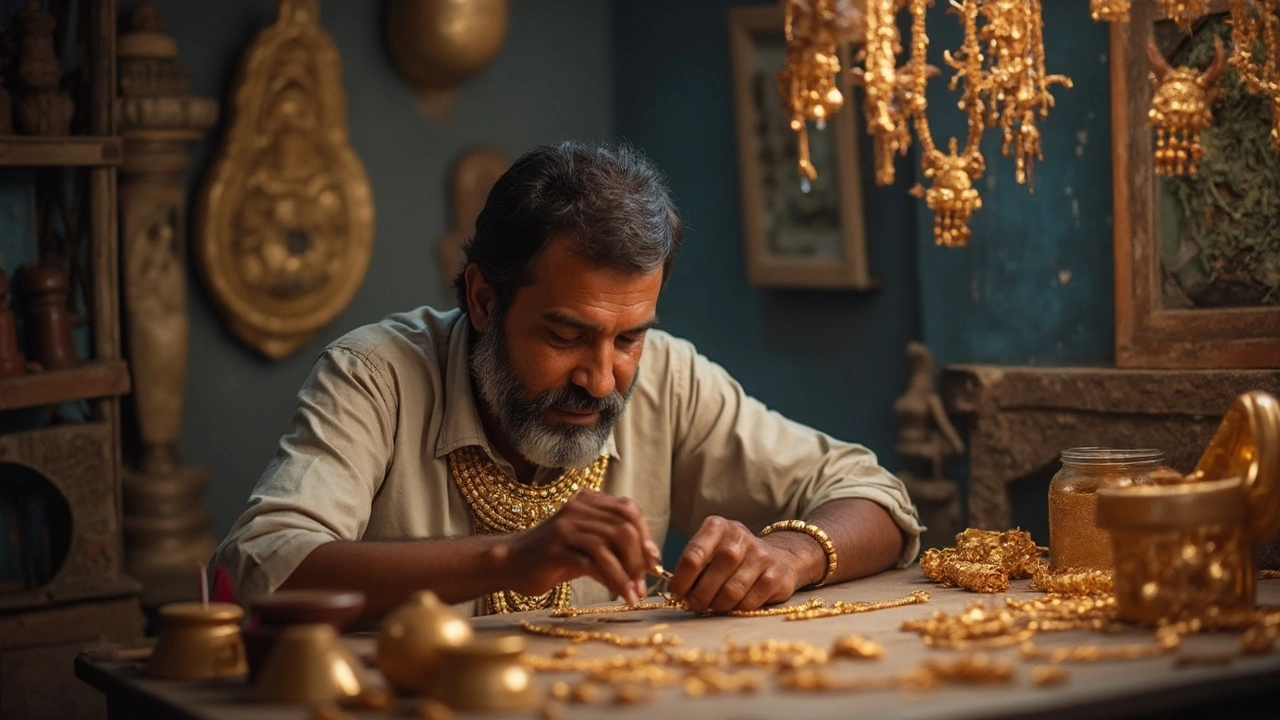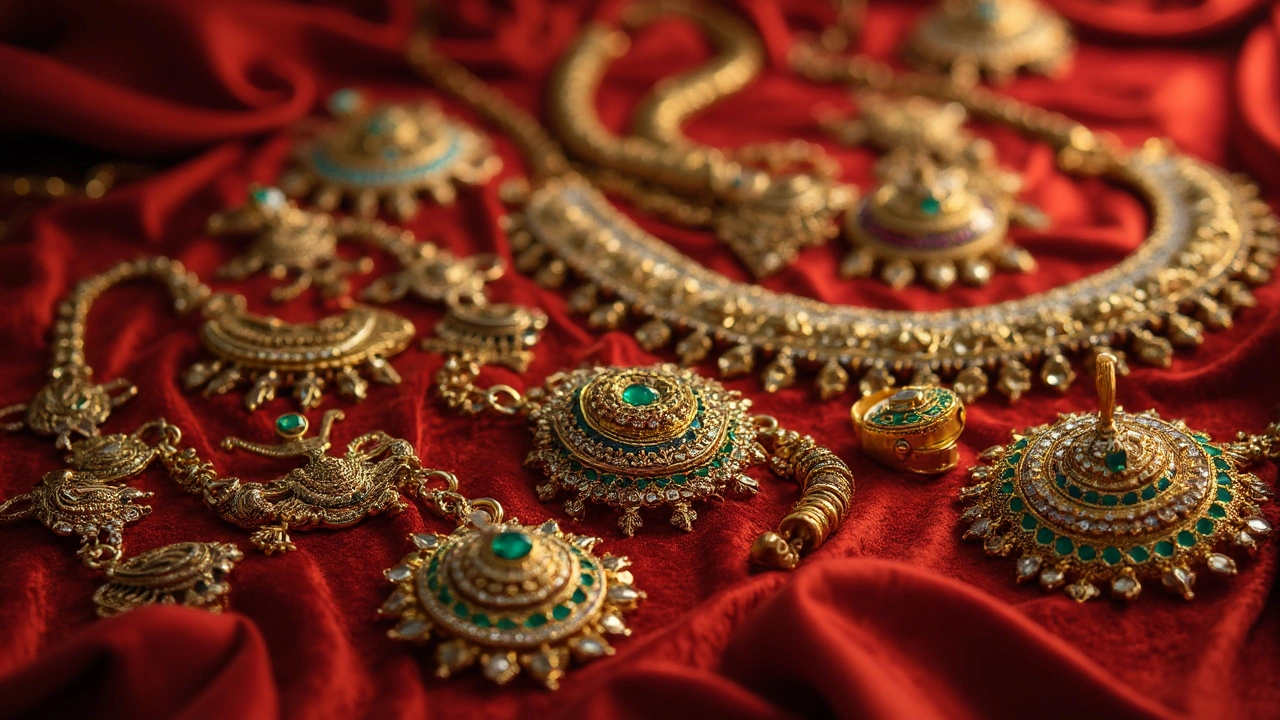If you've ever wondered about the magic behind authentic Indian jewelry, you're not alone. Indian jewelry, especially temple jewelry, is a mesmerizing blend of tradition, artistry, and cultural heritage. But spotting the real deal isn’t always a piece of cake. So, how can you tell if it's genuine? Let's kick things off by diving into what makes traditional temple jewelry stand out.
First off, it's important to know that temple jewelry has deep roots in religious and cultural ceremonies. Crafted with precision, these pieces often feature divine motifs like gods, goddesses, and intricate patterns that are nothing short of art. We're talking about jewelry that's been around for centuries, often created using age-old techniques passed down from one generation to the next.
What makes temple jewelry so special is the craftsmanship and materials used. Artisans traditionally use gold, silver, and precious gems, adding a rich and opulent feel to each piece. But, it's not always the bling that speaks volumes—it's the skilled hands shaping these materials into something almost sacred.
- Understanding Temple Jewelry
- Materials and Craftsmanship
- Identifying Hallmarks and Authenticity
- Common Fakes and How to Avoid Them
- Tips for Buying Real Indian Jewelry
Understanding Temple Jewelry
Temple jewelry holds a special place in the vast world of Indian jewelry. Originating in the Southern parts of India, primarily in Tamil Nadu and Karnataka, these pieces were initially crafted to adorn idols in temples. Over time, they became an integral part of bridal and classical dance attire, especially Bharatanatyam and Kuchipudi.
The defining feature of temple jewelry is its intricate designs, boasting motifs inspired by deities, animals, and nature. Craftsmen often replicate shapes and forms seen in ancient temples, making each piece a tribute to age-old traditions. This is why many of these ornaments capture so much reverence.
Most often, temple jewelry is created using pure gold, and occasionally incorporates precious stones like rubies, emeralds, and pearls. The use of Kundan work, where gems are set into gold foil, is a hallmark of authenticity. This painstaking method is not just a technique but a dedication to preserving heritage.
Historically, these pieces were handed down through families, a testament to their timeless value and durability. Imagine wearing something that holds stories from several generations back—it's like owning a piece of history! The craftsmanship and attention to detail distinguish genuine temple jewelry from mass-produced, less authentic alternatives.
This authenticity isn’t just about the materials or designs; it’s a reflection of the emotions and rituals depended on these beautiful creations. When you look at a piece of real temple jewelry, you’re not just seeing an ornament, but a vibrant tapestry of culture and devotion. If you're thinking of acquiring such a piece, understanding its origin and significance can be a rewarding part of the journey.
With the right knowledge, identifying authentic temple jewelry becomes a deeper connection with art and tradition, offering more than just beauty—it offers a story to share.
Materials and Craftsmanship
When it comes to Indian jewelry, especially temple jewelry, the materials used are as important as the designs themselves. Typically, gold is the go-to choice. It's not just any gold; for temple pieces, you'd usually see 22-karat or even higher purity. This high-grade gold not only enhances the beauty but also boosts the piece's durability, ensuring it lasts through generations.
But jewelry is not all about gold. Silver plays a starring role too, especially when it comes to crafting intricate figurines on the pieces. Combine that with precious gems like rubies, emeralds, or pearls, and you've got jewelry that's not just about looking good—it's about telling a story.
The real magic happens with the craftsmanship. Imagine artisans working for hours on end, creating designs that haven't changed much over the centuries. Everything from melting the gold, hand-setting the gems, to polishing the final product requires skill, patience, and a deep understanding of the craft. Traditional techniques, like the lost wax method, are still in play, adding that authenticity you can't fake.
One way to spot real temple jewelry is to look closely at the detailing. Does it have intricate engravings? Are the motifs meaningful and culturally significant? Mass-produced pieces just can't replicate the meticulous work that goes into genuine temple jewelry.
For those of you keen to get your hands on genuine stuff, here's a neat little cheat sheet:
- Check the weight: Authentic pieces are heavier due to the denser gold and silver used.
- Look for hallmark stamps: These are often hidden in small areas to confirm gold purity.
- Observe the gem settings: Real temple jewelry features tight, meticulous gem settings snugly fit without glue.
Whether you're buying or just admiring, knowing the materials and craftsmanship makes you appreciate the artistry that much more. Plus, it helps weed out those pesky fakes more easily!

Identifying Hallmarks and Authenticity
When it comes to spotting authentic Indian jewelry, especially the exquisite temple jewelry, knowing how to identify hallmarks is a game changer. Hallmarks are tiny markers or symbols stamped on a piece of jewelry. They tell you a lot about the metal content, purity, and sometimes even the artisan who crafted it.
The first hallmark to look for is the BIS hallmark if you're dealing with gold jewelry. The Bureau of Indian Standards (BIS) approves this mark, which guarantees the purity of gold. Keep an eye out for a tiny triangle that includes a BIS standard mark, fineness number (like 916 for 22-karat gold), and the jeweler’s identification mark.
Silver jewelry should have a similar hallmark. It often features a quality mark—92.5 for sterling silver—and sometimes a date letter or a maker's mark, which is unique to the jeweler or manufacturer. These are often tiny symbols or letters, so a magnifying glass might come in handy.
If you’re looking at pieces with precious stones, sometimes there’s an additional mark to indicate the origin or authenticity of gemstones. While it's not as common, higher-end pieces might include these for full transparency.
Another pro tip is to examine the craftsmanship closely. Real Indian jewelry won’t show flimsy soldering or uneven patterns. Authentic temple jewelry, in particular, is known for its flawless, intricate detailing. So, if anything looks sketchy, it probably is.
Common Fakes and How to Avoid Them
When you're on the hunt for authentic Indian jewelry, it’s easy to get lost in all the sparkle. But, there’s no shortage of fakes out there, trying to pass off as the real McCoy. Let's dig into how you can dodge these impostors.
First thing to watch out for: the material. Genuine temple jewelry is often crafted from high-quality gold or silver. If you come across something that feels too light or bends easily, that's your red flag. Real metals have a certain heft and resilience. A simple test? Try the magnet check. Gold and silver aren’t magnetic, so if the jewelry gets pulled, you know it’s not the real deal.
Also, have a close look at the details. Authentic pieces are known for their intricacy with precise, clean lines depicting motifs and symbols. Fakes typically cut corners with sloppy craftsmanship.
Another clue lies in the gems adorning the jewelry. Real temple pieces often use semi-precious stones. Fakes might use glass or plastic, so examine them under good lighting. Scratching the surface lightly can reveal if it’s real stone or just an imposter.
Of course, the hallmark is a telltale sign. Genuine items carry a hallmark indicating metal purity, crucial for authentic jewelry. Lack of a hallmark or one that’s poorly done can point to a fake.
"It’s essential to educate yourself on hallmark signs, as they confirm the authenticity and value of the jewelry," says jewelry expert Suresh Iyer.
Be aware of the too-good-to-be-true deals. If someone’s offering a 'golden’ piece at an unbelievable price, it might just be unbelievable! Stick to reputable dealers or jewelers who stand by their products with a certificate of authenticity.
Here’s a quick list to avoid fakes:
- Check for proper weight and magnet test.
- Inspect the intricacy of design.
- Confirm genuineness of stones.
- Look for clear hallmarks indicating metal purity.
- Buy from reputable sources.
Take these tips along when you're out there adding to your collection. Remember, it’s not just about buying a piece of jewelry. It’s about investing in art and heritage.

Tips for Buying Real Indian Jewelry
Buying authentic Indian jewelry can feel like treasure hunting, but knowing what to look for makes all the difference. Start by getting familiar with the materials. Genuine temple jewelry primarily uses gold and silver, sometimes mixed with precious stones like rubies or emeralds. Check for any hallmarks or certifications on the piece, confirming the quality and authenticity of the metal used.
Another tip is getting to know the workmanship. Authentic pieces will have intricate designs that aren’t just glued or stamped on. If you spot lazy or uneven patterns, it's probably a fake. Real artisanship shines through consistency and detail, which should be noticeable even in the tiniest elements.
Research the seller. This might sound like basic advice, but you'd be surprised how often people skip it. Buy from reputable jewelers—ones with good reviews and a strong reputation. Ask questions about the piece’s history; a reliable seller will always have answers and documents to prove a piece's authenticity.
Consider attending an exhibition or contacting an expert appraiser if you’re splurging on a particularly expensive piece. An expert can offer insights and validate authenticity, saving you from costly mistakes. They know the ins and outs of Indian jewelry, spotting fakes just like a Sherlock Holmes of gemstones.
Lastly, go with your gut—sometimes intuition is key. If something feels off, step back and take a closer look or even walk away. Real Indian jewelry often has a story that resonates, making it feel special from the start.
By keeping these tips in mind, you'll be better equipped to navigate through the market and snag a piece of authentic beauty that not only looks stunning but also carries a certain cultural richness with it.



